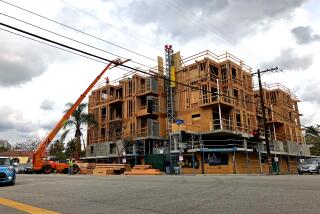Council OKs Occupancy Limits on Rental Units
- Share via
The Los Angeles City Council on Friday unanimously approved an ordinance limiting the number of people who can occupy an apartment or rented house. It adopted a companion measure that seeks to help tenants who may be evicted because of overcrowding.
Despite protests by tenant groups that it could still spark evictions, the controversial ordinance--which already had been approved once and then subsequently rejected by the council in April--was hailed as a weapon to combat worsening public health problems and deteriorating neighborhoods.
The measure, which will take effect July 1 if Mayor Tom Bradley signs it, would restrict the number of tenants who live in an apartment or rental house based on the square footage of sleeping areas.
Space Requirements
Under the ordinance, 70 square feet of sleeping space would be required for two persons and another 50 square feet for each additional person. City officials calculate that this formula would permit up to 10 people to live in a moderate-sized two-bedroom apartment.
During the months of debate over the overcrowding proposal, proponents steadfastly have argued that as many as two dozen people have been crammed into small, two-bedroom apartments throughout the city. They say that many are poor or living here illegally and are victimized by unscrupulous landlords.
Councilman Ernani Bernardi, one of the most vocal backers of the ordinance, produced a letter Friday from the Los Angeles County Department of Health Services that blames crowded conditions for helping spread such diseases as tuberculosis.
In the 1983-84 census, Bernardi said, 30% of the housing units in the city’s central district were considered overcrowded and the tuberculosis rate in that area--73.2 cases per 100,000 people--was four times the county average.
“That’s what we’re dealing with,” Bernardi told his colleagues, “and that’s the risk we’re dealing with if we keep stalling this issue.”
Tenant organizations, however, tried futilely to persuade the council to delay a vote on the overcrowding ordinance.
“This is a dangerous gamble with tenant lives,” said Larry Gross, director of the Campaign for Eco nomic Survival. “What if there are no safeguards after six months; will tenants be prey to slum landlords?”
Dino Hirsch, director of Inquilinos Unidos (United Renters), a tenants rights group, contended that the ordinance was aimed at large families “and the Spanish-speaking community . . . in downtown and East L.A.” and would swell the city’s homeless population.
The council sought to reassure tenants by passing a companion measure that would:
- Require landlords to give written notes to tenants advising them of the maximum number of occupants in a rental unit.
- Ban landlords from retaliating against tenants who complain to authorities about the conditions of their apartments or houses.
- Require landlords who evict tenants for overcrowding to offer “in good faith” alternative housing of adequate size.
- Make any violation a misdemeanor punishable by a fine of up to $1,000 and/or six months in jail.
But the ordinance left it to the Rent Adjustment Commission, with the help of other city agencies, to determine specifically what rules and regulations would govern the ordinance and resolve questions, such as what would constitute a “good faith” offer by a landlord and what responsibilities a tenant would have.
The commission is supposed to report back in three months, and Councilman Robert Farrell promised tenant groups that those safeguards will be implemented.
More to Read
Sign up for Essential California
The most important California stories and recommendations in your inbox every morning.
You may occasionally receive promotional content from the Los Angeles Times.










